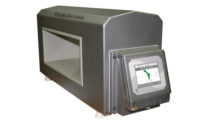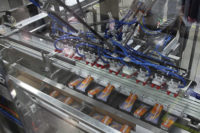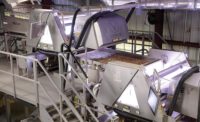Inspection and detection solutions










Bakers and snack manufacturers are continuing to expand their product lines and offerings in response to consumer demand. So when it comes to their processing lines, flexibility is key. Metal detection and X-ray systems must be able to handle a wider range of products, offer quick turnover and store multiple product settings.
“Bakery and snack food producers are looking for increased flexibility in their inspection equipment,” says Kyle Thomas, strategic business unit manager, Eagle Product Inspection, Tampa, FL. “In response to changing consumer demands, they are producing a number of different items at their facilities. Therefore, they need technology that can accurately detect and reject foreign body objects in a variety of products with different packaging formats, packaging materials and food types. The ability of a machine to run multiple lanes of food items and accurately identify physical contamination in different types of packages enables manufacturers to reduce downtime for changeovers, effectively increasing their output and product offering.”
Consumers also want more variety, which is driving a greater assortment of products, as well as packaging shapes, sizes and formats, says Stephen Dryer, product manager, Mettler Toledo CI-Vision, Aurora, IL. Consequently, lines that used to run one dedicated product type for long periods are now churning out more small batches.
“Each changeover cuts into production time and introduces opportunities for errors—human or otherwise—to creep in,” says Dryer. “Inspection equipment that can be quickly, precisely and reliably reconfigured to allow for these frequent, fast-paced changeovers is essential.”
Conveyor configurations and reject devices need to be designed to handle this variety, according to Pat A. Fricano, marketing manager, Advanced Detection Systems, Milwaukee. “It is no longer enough to buy a standard inspection-detection system and expect it to handle the challenges of today’s production environment,” he says. “Thus, it is critical to work with a supplier that can custom-design a system, taking into account all variables to provide the right solution.”
Geri Foley, metal detection sales manager, Mettler Toledo Product Inspection, Tampa, FL, sees increased requests for incoming raw materials and finished products for contaminants. “Contaminated raw materials not only can make it through to the finished product, they also can affect production processes and processing equipment,” he says.
New equipment, enhanced features
Fortunately, a host of recent inspection-detection equipment introductions and improvements are helping bakers and snack producers meet customer needs. Advanced Detection Systems’ ProScan Max II metal detector, for instance, now features enhanced performance validation that lets producers schedule and confirm metal detector performances. An alarm is activated when the test is scheduled and remains on until the test is performed. The events are logged and available for production supervisors and outside auditors to review.
Thermo Fisher Scientific, Waltham, MA, recently upgraded its NextGuard X-ray inspection system, adding product verification software and an enhanced detector to improve sensitivity. The product-verification software allows customers to use a pull-down menu to quickly select and sequence a range of image processing and analysis algorithms. Users can conduct a wide range of inspection based on size, shape, angle, count and position in minutes.
Thermo Fisher Scientific also launched a new bulk flow X-ray system in its Xpert family. “This unit was developed for ingredient suppliers,” says Bob Ries, lead product manager, metal detection and X-ray inspection for the company. “It enables fast and accurate foreign-object detection in raw materials such as nuts, fruits and seeds. The objective is to sort out problems before they leave the processing area and make their way to production and packaging.”
Heat and Control Inc., Hayward, CA, recently unveiled the Ishida IX-G2 dual-energy X-ray system, which improves detection of low-density foreign objects in products that overlap or have uneven surfaces, such as cereal and frozen foods. The system includes functions for weight verification and the detection of missing items, incomplete filling, product defects, incorrect alignment and product trapped in package seals.
Heat and Control also offers the CEIA THS/MS21, a multi-spectrum metal detector that eliminates false rejects caused by product effect, while maintaining high sensitivity to all metals. “Product effect occurs when a product characteristic or ingredient simulates the presence of metal,” says Todd Grube, product manager, inspection systems for the company. “The CEIA THS/MS21 uses a spectrum of multiple frequencies simultaneously and continuously to identify and mask the product effect while maintaining maximum sensitivity to all metals, including 316 stainless steel.”
Grube notes that product effect issues can pose problems for producers of bakery products and prepared foods—particularly nonhomogeneous or multicomponent products.
SICK Inc., Minneapolis, recently introduced PDT (product dimensioning and trending), a 3-D inspection system for offline and online product quality and size verification. It includes 3-D vision systems, a human-machine interface (HMI) and software with selectable parameters for 3-D size information. “It gives customers real-time feedback on product sizing to reduce giveaway and waste,” says Mark Langridge, director, sales and marketing, packaging, food, beverage and consumer goods for the company.
Mettler Toledo has unveiled the Mosaic Compact, a turnkey vision inspection solution for round, unoriented consumer packaged products, such as snacks in canisters. Using a new technique for 360-degree inspections, the Mosaic Compact protects against mislabeled or improperly marked packages, safeguarding brands and consumers. “In addition, the system helps maintain label quality through checks on label application, ensuring that products look their best on retailer shelves,” says Dryer.
Mettler Toledo also offers C3000 System checkweighers. The series includes the CM3570 CombiChecker, an integrated checkweigher and metal detector that perform two key inspection functions in one integrated solution. Checkweigher and metal detector setup and configuration are performed at the control panel, saving time and simplifying operation.
“Product changeovers result in automatic adaptation of each inspection device to the new package parameters,” says Mark Feher, business development manager, Mettler Toledo Product Inspection. “Easily customized from standard modules, this dual-function system can be adapted to suit the specific requirements of each end user.”
Eagle Product Inspection recently launched the Material Discrimination X-ray (MDX) with Easy MAT software, which accelerates and simplifies setup by auto-learning a product’s material composition and identifying foreign-body contaminants. In addition, the system’s intuitive, preprogrammed, operational HMI reduces the need for third-party setup and maintenance.
“While standard X-ray technology provides accurate detection of contaminants such as stainless steel, ferrous and nonferrous materials, MDX technology ensures detection of inorganic contaminants, such as glass shards, stones, rocks and low-density plastics and rubbers,” says Thomas. “Its ability to identify materials and contaminants based on chemical composition, which is unique to each product, makes it a valuable asset to production lines that handle a range of multiple textures such as peanuts and trail mix.”
Looking ahead, food-safety concerns and requirements will continue as one of the main forces driving the evolution of inspection-detection equipment. Manufacturers will also focus on improved machine sensitivity and reliability, monitoring detection events and test procedures, increasing product profile storage and numerous other concerns important to their customers so that they, in turn, can continue to deliver safe snacks and baked goods to retailers and consumers.
Looking for a reprint of this article?
From high-res PDFs to custom plaques, order your copy today!











